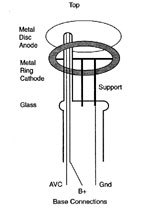VG-1 tuning indicator VISO-GLO
VG-1 tuning indicator VISO-GLO

Sparton´s Viso-Glo VG-1 was an ephemeral creature. The glow-tube tuning indicator appeared only for the 1934/35 season, and was already one year later superseded by the first real "magic eye" 6E5.
The VG-1 is found in the Canadian Sparton Models 467B and 580 as well as in the US models 104, 136 and 83.
Sparton kept the name Viso-Glo for the 6E5.
The list price for a VG-1 was $2.-, while a 6E5 was only $1.50!
There was no trace in the literature for more than 60 years, until an article was issued in the OVRC Newsletter, the bulletin of the Ottawa Vintage Radio Club, vol.8, No.4, Winter 2000. Authors: Gordon Symonds, Jim Berg, Ludwell Sibley and Lea Barker.

Here is the illustration from the OVRC Newsletter regarding the inner structure.
There is some misinterpretion!

In fact the ring is not the Cathode, it is a support made from mica. The metal disc is the Cathode, and it has a hole near the rim.

Two wires are protruding through this hole : Anode A1 at the rim side, and Anode A2 facing the center of the Cathode disc.
A1 is connected via 1 Megohm to +B (450 Volt), acting as a kind of "pilot flame".
A2 is connected via a potentiometer (for indicator sensitivity adjustment) to the varying anode voltage of the variable mu tube(s). With a strong signal the reduced plate current will increase the voltage (decreased voltage drop at series/filter resistor) and cause more glow discharge in the VG-1.
Since the VG-1 is arranged behind a fan-like mask,the Viso-Glo Bezel, its radials will lengthen and shorten with varying signal strength: "...a small six-pointed star grows in size..." says an advertising (although there are eight...).
Viso-Glo bezel

Authors epilogue:
Unfortunately my one and only VG-1 had suffered a crack, which made the inert Neon mixed with ordinary air.....no more glow...
I made a replacement by a standard neon tube, which now only changes intensity, not the radial length...
To thank the Author because you find the post helpful or well done.
Viso-Glo patent

Greetings Konrad.
I thought you might want to have a look at the original patent. I found it here.
Best Regards,
Howard
To thank the Author because you find the post helpful or well done.
VisoGlow patent

Hello Howard,
isn't it interesting, that the tube came in use around the time of patent application,
while it was already out of use when the patent was granted...
thank you very much!
Kind regards,
KoBi
To thank the Author because you find the post helpful or well done.